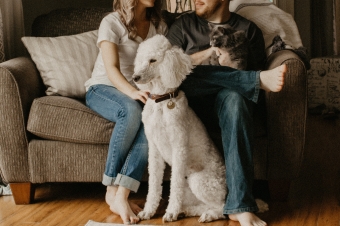People always think about the fire alarms in their homes, but it is important not to discount the importance of a carbon monoxide detector. Prolonged exposure to carbon monoxide—an odorless, tasteless, invisible gas—is quite deadly and fuel-burning devices have the potential to emit it. Forbes reports that this poison sickens 20,000-30,000 people and 500 perish from it.
Just as fire alarm placement deserves careful consideration, you need to think about where a carbon monoxide detector will provide the most protection for you and your family.
One per Floor
Ideally, you should have one carbon monoxide detector per floor in your home, including the attic and garage (if you park your vehicles there). This ensures you have maximum protection, as it is possible for the gas buildup to only be present on a single floor of the dwelling. While it might be fine in the main level, the top floor or bottom floor may contains hazardous amounts of carbon monoxide.
Place the detectors within ten feet of the area you wish to protect and away from anything that might block its ability to monitor the air (e.g. drapes). In addition, be sure to keep the devices out of the reach of children.
Keep one near your bedrooms. Homes with children, seniors, or other vulnerable persons should consider having more than one on that particular floor. Place other units in parts of the home where people frequently spend time, such as the kitchen, living room, and office/den. Definitely include one in the basement with your furnace.
Five Feet off the Ground
While you would place fire alarms on the ceiling, carbon monoxide detectors are most effective when they are five feet off the ground. Insure that the detector is at least two feet away from the ceiling. Carbon monoxide is lighter than air and will float up. However, as it is usually the result of a heat-generating device that is not functioning correctly, the carbon monoxide may not rise right to the top of the ceiling due to a cushion of warm air.
Detectors need electricity to work and that has resulted in some placed too close to the floor, so the cord will reach the outlet. Make sure this is not the case.
There are detectors available that monitor for both smoke and carbon monoxide. Such models would go on the ceiling.
Not Near Fuel Burning Appliances
While these devices are designed to detect when fuel-burning appliances are malfunctioning, you should not place the detector near one. These give off some carbon monoxide, but not enough to be harmful when functioning properly. As a result, you may get a false positive reading when there is actually no danger at all.
Avoid Humidity and Sunlight
Your device should also not be in close proximity with areas of the home that are typically humid (e.g. bathrooms) or bathed in sunlight. These can both negatively affect the device’s ability to operate and provide accurate readings of the air.





